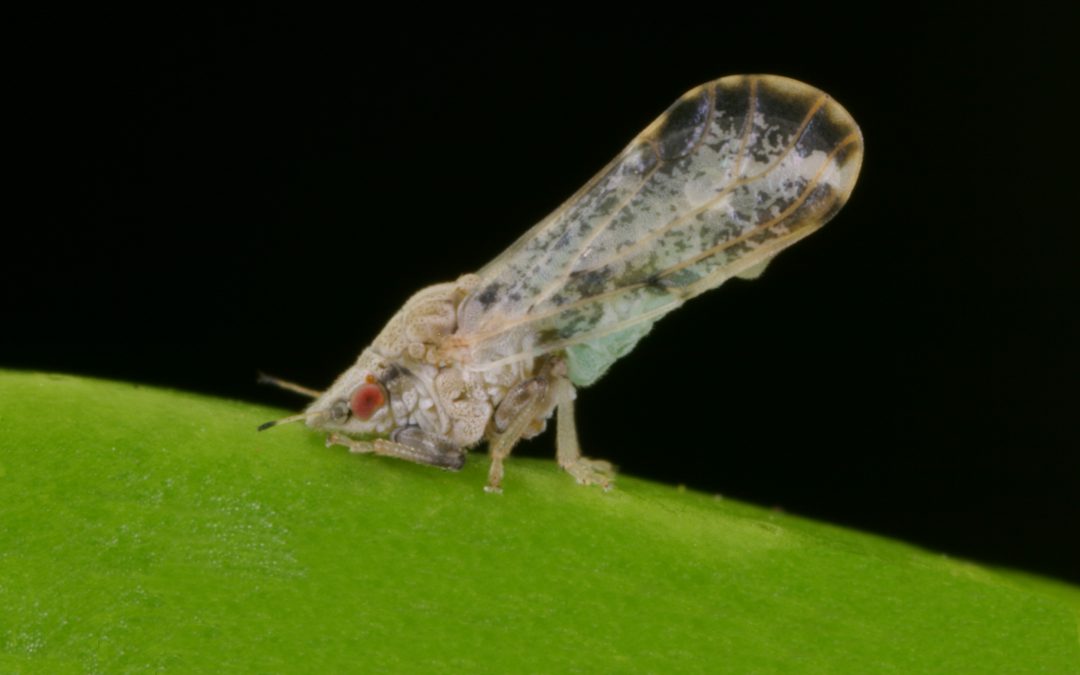
by Mark Tancig | Jan 13, 2022
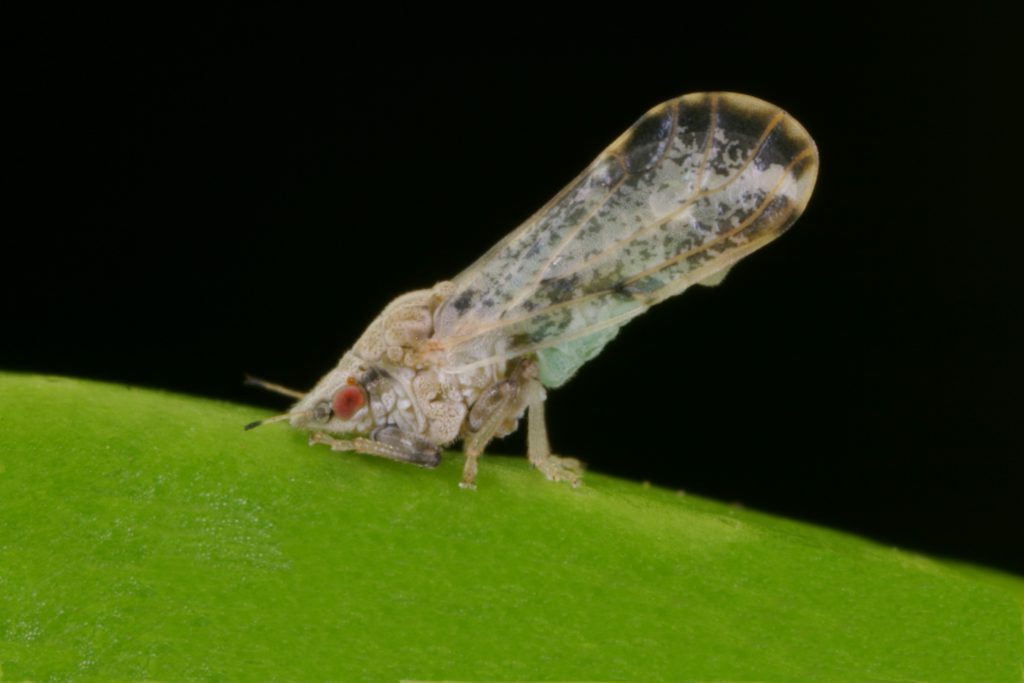
Asian citrus psyllid, Diaphorina citri. UF/IFAS/Entomology Photo: Michael Rogers.
In late 2016, as many of us were enjoying the harvests from our backyard citrus, a bacterial plant disease that can affect all citrus, citrus greening, was widespread in central and south Florida but had not made it this far north. That year, the vector, the insect that spreads the disease from tree to tree, had been found in Leon County and a few other surrounding Panhandle counties, but the disease had not. By mid-2017, the disease had been confirmed in Franklin County and we hoped that our cooler temperatures could keep the insect and disease at bay. Well, I regret to inform you that the disease has also now been confirmed in Leon County, growing in a residential yard in Tallahassee. Now that it is confirmed in non-coastal (and cooler) north Florida locations, I thought a review of the signs and symptoms – as well as what to do with your tree if you suspect or confirm greening – would be helpful.
The tricky part about diagnosing citrus greening is that it has symptoms that look very similar to soil nutrient deficiency symptoms, especially when first infected. This is a good time to mention that citrus require certain micro-nutrients for optimal growth and a citrus-specific fertilizer product should be used when applying fertilizer. Both the disease and certain nutrient deficiencies cause yellowing of the leaves. With greening, the yellowing is typically blotchy and/or not in any particular pattern. Nutrient deficiencies typically cause unique patterns of yellowing, such as a V-shape or artistic-like symmetrical patterns on each side of the leaf’s midvein. The soil’s acidity, or pH, can also cause some nutrients to not be taken up by the plant even if they are present. Soil testing, available from your local UF/IFAS Extension office, and scheduled fertilizations with a citrus-specific fertilizer can ensure that nutrients are not to blame for the discoloring of leaves. More advanced stages of the disease cause such symptoms as leaf drop, fruit drop, lop-sided fruit, uneven inner fruit cores, and reduced fruit quality.

Citrus greening symptoms of the fruit. Photo by Brooke Moffis.
A more obvious sign of potential problems for your citrus are the presence of the insect vector, the Asian citrus psyllid. This is a tiny little insect that goes from one leaf to the other sucking up plant saps for food and unknowingly spreading the bacterium responsible for citrus greening. You can monitor for them by looking closely at the new flushes of growth. If the psyllids are present, you will likely notice most their small, peach-colored eggs and/or white, waxy secretions. If found, it doesn’t necessarily mean that your tree has greening, but you will want to minimize the chance that they could carry it to your tree. The psyllids can be treated with pesticides, ranging from the less harsh options (horticulture oils, neem oil, kaolin clay) to the more hardcore stuff (malathion, carbaryl, imidacloprid). Of course, always read the label of any pesticide before use and/or consult a qualified landscape professional for assistance.
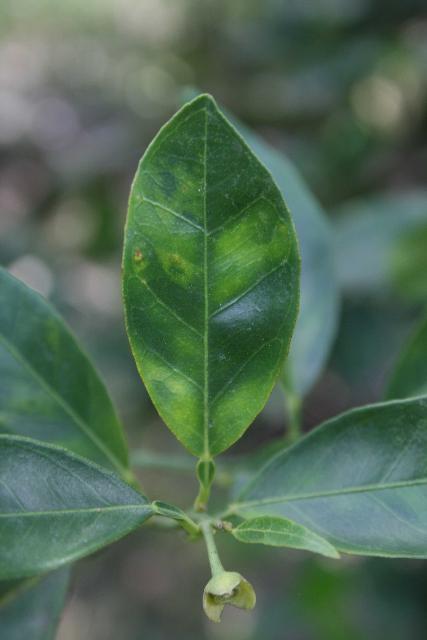
Blotchy leaf symptom of citrus greening. Photo by Jamie D. Burrow.
If you suspect your tree is infected, a diagnostic test can be performed by UF/IFAS plant pathologists at the North Florida Research and Education Center (NFREC) in Quincy to confirm. The test does cost $50, which may seem a little steep, but it’s an expensive lab analysis to run and may be worth piece of mind.
If citrus greening is confirmed in your tree, the right thing to do, unfortunately, is to remove and burn the plant material as there is no known cure. While the Florida Department of Agriculture and Consumer Services (FDACS) doesn’t have any removal requirements for infected dooryard citrus, tree removal is best to prevent additional spread of the disease to other trees, especially those grown by commercial producers in our area. This may seem drastic but eventually the health of the tree and quality of the fruit will decline to a point where you will want to remove it anyway. Don’t forget that movement of any citrus plant outside of the state is prohibited for the very reason of preventing spread of citrus diseases.
You may be asking, “Is it okay to replace it with another citrus tree?” The answer is yes you can, but you do risk re-infection and will want to be monitoring the new planting.
You may also be thinking, “What is going to happen to Florida citrus?” That’s a question that many researchers at UF/IFAS are trying to answer. There is some hope that intense irrigation and nutrient management, as well as specific pruning practices, can help infected trees continue to be profitable for commercial growers. Recently, UF/IFAS researchers were awarded several grants to try and figure a way out of this problem. Some of the lines of research focus on exploring the resistance found in different citrus varieties, including an Australian lime that appears to be greening resistant. This could potentially be used as a future rootstock. Another approach is to try and treat the plants with a particular peptide that would prevent the disease from binding in the insect’s gut. Isn’t that amazing?
Until a fix is found, we should be monitoring for this disease in our area and taking steps to reduce its presence through controlling the psyllids and removing infected trees. If you suspect a tree has greening, please contact your local county Extension office to review the symptoms and discuss your options.
Much more information on citrus greening is available at the following Ask IFAS website: https://edis.ifas.ufl.edu/entity/topic/citrus_greening and from this 2017 article – https://nwdistrict.ifas.ufl.edu/phag/2017/03/03/disease-alert-citrus-greening-and-asian-citrus-psyllids-found-in-the-panhandle/.

by Larry Williams | Jan 6, 2022
Q. When is citrus fruit ready to harvest?

Satsuma fruit ready to harvest. Photo credit: Larry Williams
A. Florida uses five indexes to determine maturity of citrus, including soluble solids, juice content, acid level, soluble solids/acid ratio and skin color. But, the home gardener can easily decide when most citrus types are ready to be harvested. As the fruit reaches full size and the skin color changes from green to greenish yellow to orange, simply pick some fruit and taste it to see if it is sweet. If not, wait a little longer (a week or two) and taste test another fruit. Meyer lemons are ready when the skin color changes from green to greenish yellow. Satsuma fruit may be ready to eat before the skin becomes completely orange, especially if the early fall is warm. Kumquats are usually at their peak in taste when they become fully orange.
Citrus fruit does not ripen additionally after it is harvested. So, let it mature sufficiently on the tree.
Harvest season for satsuma is October to December. Harvest season for Meyer lemon is November to March. Harvest season for kumquat is November to April. Most grapefruit have a harvest season from November to May. Harvest season for sweet oranges varies. Early season oranges are harvested October to January, mid-season oranges are harvested December to February and late-season cultivars are harvested March to June. Citrus fruit may mature a little earlier in the harvest season on mature trees and more toward the end of the harvest season on young, vigorous trees.
Q. What cold-hardy citrus is best for North Florida?
A. Citrus species are tropical and subtropical in origin. As a result, citrus is not well suited for extreme North Florida. Commercial citrus production has progressively moved further south in Florida due to historic freezes. So, you’d be wise to choose the more cold-hardy citrus types for our area. But, even cold-hardy citrus can be severely injured or killed by a hard freeze in North Florida.
Some of the better choices for cold-hardy citrus in North Florida include kumquat, satsuma, calamondin and Meyer lemon. There has been some success with grapefruit and sweet oranges in our area. Lemon and lime are much less likely to survive in North Florida. There has been some discussion concerning future success with growing citrus a little more north in its current range related to climate change. There already has been some success with growing the more cold-hardy citrus types such as satsuma and kumquat in middle Georgia. We’ll see how this works out.
More information on cold-hardy citrus is available from the UF/IFAS Extension Office in your County and through this link. https://crec.ifas.ufl.edu/extension/trade_journals/2018/2018_june_coldhardy.pdf
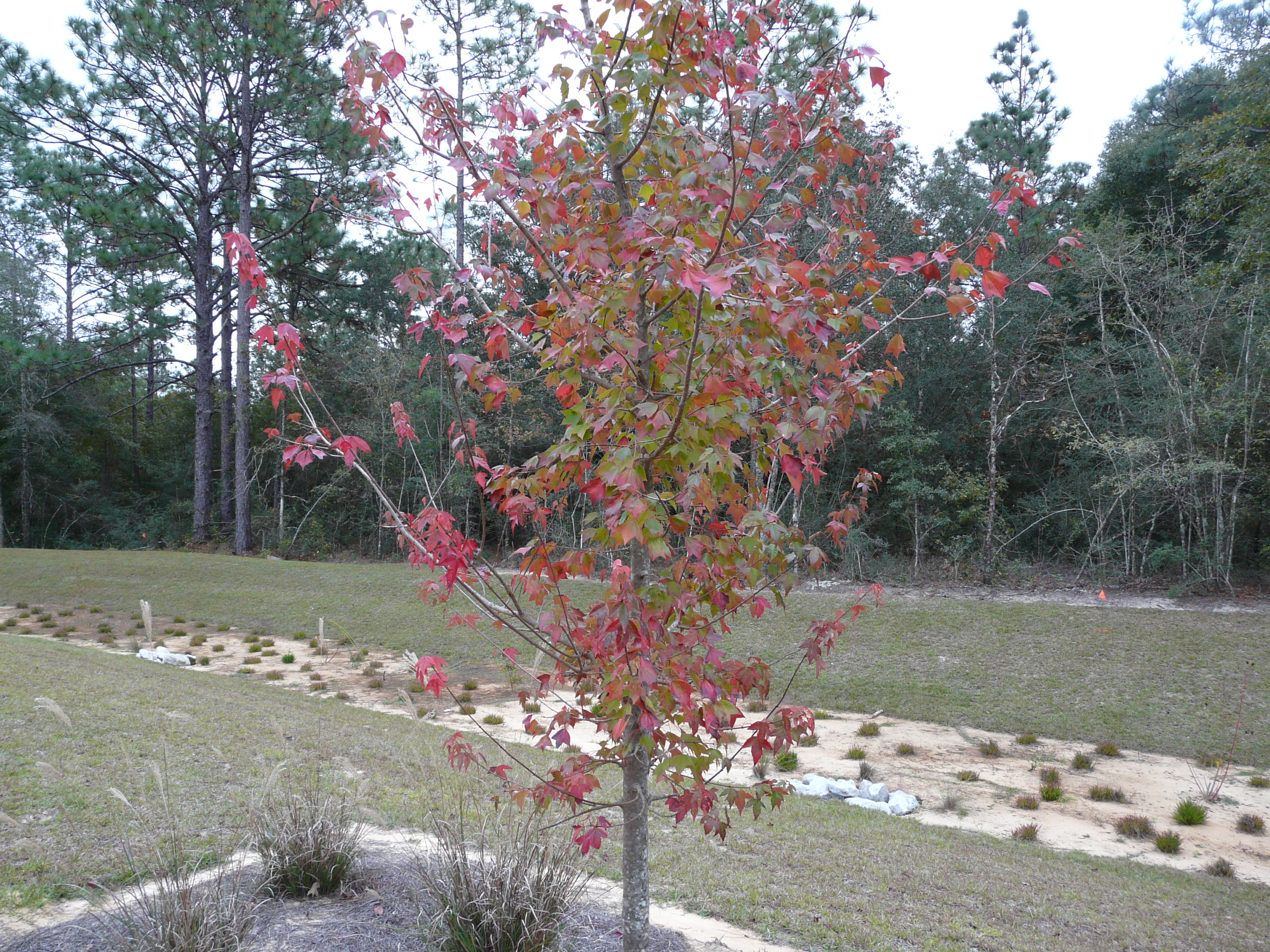
by Matt Lollar | Dec 16, 2021
Trees provide shade, aesthetics, and perspective to the landscape. However, they only serve as burdens if not properly selected and maintained. To help determine what trees do best under certain conditions and to provide information on tree care, this month’s Gardening in the Panhandle LIVE! was all about trees.
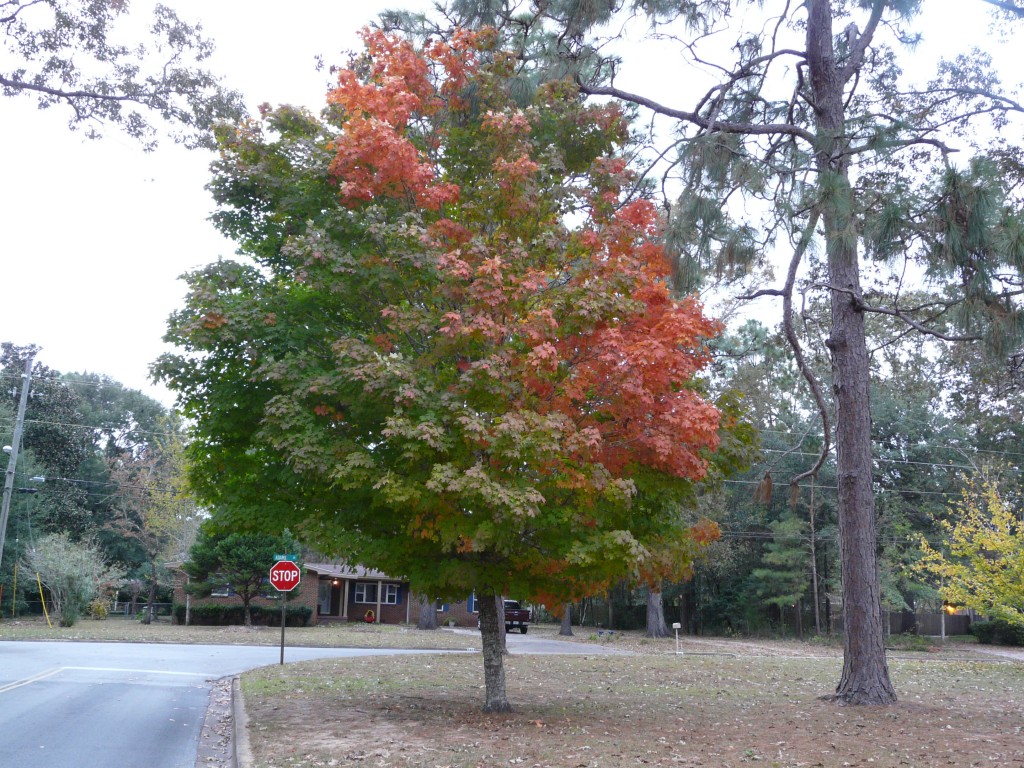
Florida maple beginning to exhibit fall color. Photo credit: Larry Williams, University of Florida/IFAS Extension – Okaloosa County
Tree Selection
Some trees grow faster than others. That’s not always a good thing, but if you’re trying to select a tree that grows fast and will provide shade in your yard then you might want to give the following species a try. Click on the links for more information.
A lot of times you’ll read a particular tree species prefers moist, well-drained soil. Some coastal soils are very well drained and require supplemental irrigation after establishment to keep some species alive. One tree that does well in sandy, well-drained soils without supplemental irrigation is the sand live oak. Another tree, that would never win a popularity contest, but does well in sandy soils is the sand pine. This tree has a gnarly growth habit, which would make it an interesting focal point in the landscape. Turkey oaks are another option for dry spots.
There are a lot of fruit tree species that can be grown successfully in the panhandle. The key to good fruit production is selecting trees that are adapted to the average number of chill hours (usually calculated by the number of hours between 34ºF and 45ºF) your yard receives on a yearly basis. Some peaches, plums, and nectarines have been developed for our climate. Citrus such as satsumas and tangerine hybrids grow well in the panhandle, but sometimes require cold protection. Persimmons, loquats, and pears are other fruit trees that grow well.
If you already have mature trees in your yard, then you may be looking for smaller, understory trees to enhance your landscape.
Living this far south, you often have to really seek out trees that change color in the fall. Dogwoods, Florida maples, and blackgum trees all have great fall color. Some of the red oaks also have nice fall color. Two that come to mind are the nuttall oak and the Shumard oak.
Trees can cause a lot of damage if planted too close to sidewalks or buildings. To determine if a tree will fit in a confined space, you will need to consider its mature trunk flare diameter.
Florida is the southern extreme for growing ginko trees. If you decide to plant a ginko tree, make sure to select a male cultivar to avoid stinky, slippery fruit.
To successfully plant a tree, you need to start with a healthy tree. If the tree you purchase was grown in a pot, make sure it isn’t rootbound and doesn’t have encircling roots. You also should inspect the tree’s form, branching structure, and look for the presence of included bark. Please read “Selecting Quality Trees from the Nursery” for more tips on what to look out for when purchasing a healthy tree.
Some trees are more tolerant than others of high winds and flooding. Please read this publication about tree failure from hurricanes to help determine what tree species are better adapted to these weather events.
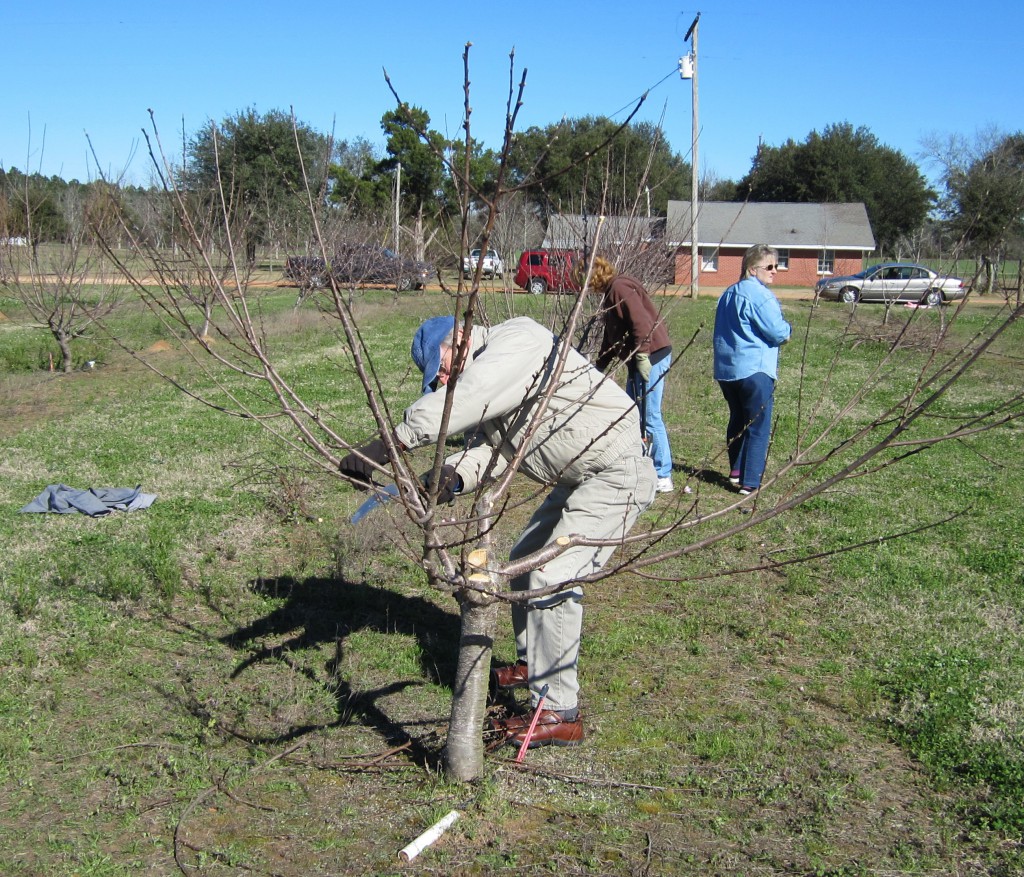
Santa Rosa County Master Gardener Pruning a Stone Fruit tree at the WFREC. Photo Credit: University of Florida/IFAS Extension
Tree Maintenance
Armillaria is a common fungal pathogen that infects trees from their roots. Other major diseases are more specific to certain species. A more comprehensive list of tree and shrub diseases can be found on the Ask IFAS website.
Tree establishment period depends on a lot of factors. Once a tree is established, it’s roots can be equal to about three times the distance from the trunk to the dripline.
Part of the beauty of a bald cypress is its knees. However they can also be a nuisance for mowing and other yard maintenance. The purpose of cypress knees is a bit of a mystery and there are a lot of theories on the subject.
Fallen leaves can help add nutrients back to your yard. Even if you are trying for a manicured lawn, you may want to rake up the leaves and use them elsewhere in the landscape.
Regardless of the species, most fruit trees benefit from a good pruning. Deciduous fruit trees should be pruned to maintain good branch structure and form, while citrus may benefit from a light hedging.
Trees are a wonderful addition to any landscape, but it’s important you select the right tree for the right place. Hopefully this article provided some information to guide you in the right direction.
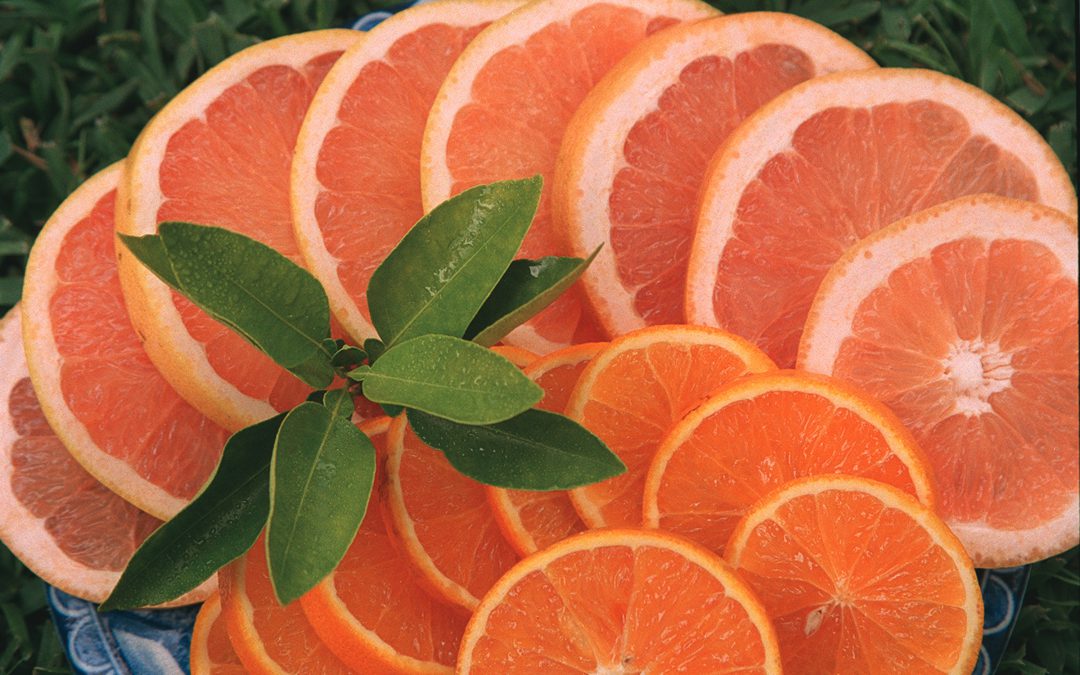
by Matthew Orwat | Nov 22, 2021

Citrus: Bearing Branches. Image Credit Matthew Orwat, UF/IFAS
Many dooryard fruit growers have asked me this Fall: When is the correct time to prune citrus? How do I prune Citrus right now? The answer may seem obvious, but when we delve into the question further, we find out that it is not.
Two different pruning strategies exist depending upon the citrus plants age. When training young citrus plants, it is essential to develop three to four main scaffold branches with wide crotch angles. This is done by selecting branches growing different directions that intersect with the trunk or each other at the widest angle possible. Other branches need to be pruned off and these need to be left alone to develop into the main scaffold. Once the branching system has been developed, traditional heading back, as seen in peaches and apples, is unnecessary.
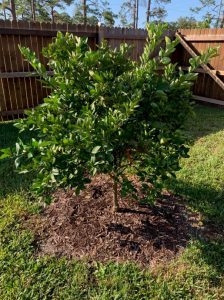
Young Citrus Tree with good vase shape
There are several instances in which pruning mature citrus trees is beneficial. First, branches should be pruned approximately one foot off the ground so developing fruit is not sitting on the ground. This also helps with weed control and fertilization. Next, it is important to remove growth that is positioned extremely upward or inward to promote an open, vase-shaped habit. Finally, it is necessary to remove any dead wood resulting from winter dieback.
Many growers are eager to remove branches that have been bent downward by heavy citrus crops. This is not necessary; they will bear well in subsequent years.
The last pruning item to consider is removal of suckers from below the rootstock. If the tree is grafted, this is necessary so that the rootstock does not overtake the scion cultivar. Trees propagated from seedage or cuttings will not need this type of pruning since root suckers will be true to type.
It has been noticed that when trees are not over pruned, they exhibit greater cold hardiness. Keeping that in mind, any pruning of citrus should be done at the beginning of March or later, not in the fall or early winter. With proper pruning practices, gardeners should expect healthy trees with bountiful harvests. For further information please consult the publications listed below or contact your local Extension office.
Citrus Culture in the Home Landscape
Cold Hardy Citrus for North Florida
Louisiana Home Citrus Production Manual
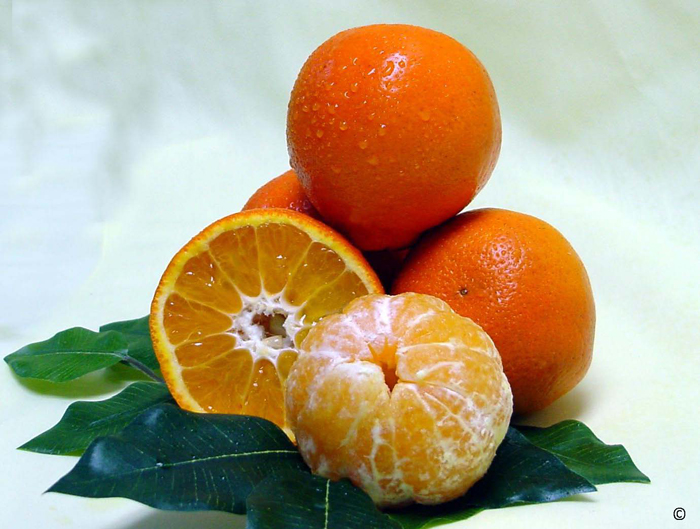
by Mary Salinas | Nov 22, 2021

Sugar Belle mandarin cultivar. Mix of sweet Clementine and Minneola varieties. UF/IFAS File Photo.
Florida is known for citrus and many homeowners love to grow and enjoy it. However, a devastating disease known as citrus greening or HLB has taken a toll on commercial and residential citrus since it first was discovered in Florida in 2005.
Sugar Belle is a cultivar of mandarin citrus developed by the University of Florida citrus geniuses and is tolerant of citrus greening disease if it is properly planted and cared for. Tolerance of the disease does not mean that it doesn’t get citrus greening, rather it means that this cultivar can get infected but still be healthy and productive. The fruit of infected trees is safe to eat as the bacterium that causes it does no harm to humans.
Our chilly winters can be detrimental to many kinds of citrus, but Sugar Belle can withstand temperatures down to 14°F once the tree is well established. That is good news for us in the panhandle. Even so, it is best to choose a spot in your landscape with a southern exposure, preferably with a wind block from northwest winds. Avoid low areas as cooler air falls into those areas.

Symptoms of citrus greening on leaves show a blotchy mottled pattern. UF/IFAS photo.
Make your purchase from a certified nursery to make sure you are getting the right cultivar and a disease-free tree. Spring and fall are the best seasons of the year to plant citrus. When planting, make sure to make slices in the rootball if it is rootbound or if circling roots are present. The rootball should be slightly above the ground level after planting. All weeds and grass should be removed under the canopy of the tree to as they compete for water and nutrients with your newly planted tree. Never place mulch against the trunk as it can hold moisture there and promote disease. Water often the first year until well-established; after establishment citrus has some drought tolerance and may only need supplemental irrigation in times of heat and drought.
A good quality citrus fertilizer with micronutrients is crucial for a healthy tree with good quality fruit. The first fertilization should be about 3 weeks after planting and then follow the label directions for subsequent fertilizations. Newly planted trees should be fertilized 6 times in the first year and the fertilizer should be evenly broadcast under the tree canopy.
The only pruning in the first 3 years should be the removal of suckers that grow from the base, water shoots that grow quickly and straight up, and dead wood. Be sure to clean your pruning tools before and after each tree to avoid spreading any possible disease. First rinse off any dirt or other organic matter and then use a 3% bleach solution or alcohol for sterilization.
Happy Gardening!
For more information:
UF/IFAS Research on Development of Sugar Belle YouTube
Citrus Culture in the Home Landscape
Citrus Greening















